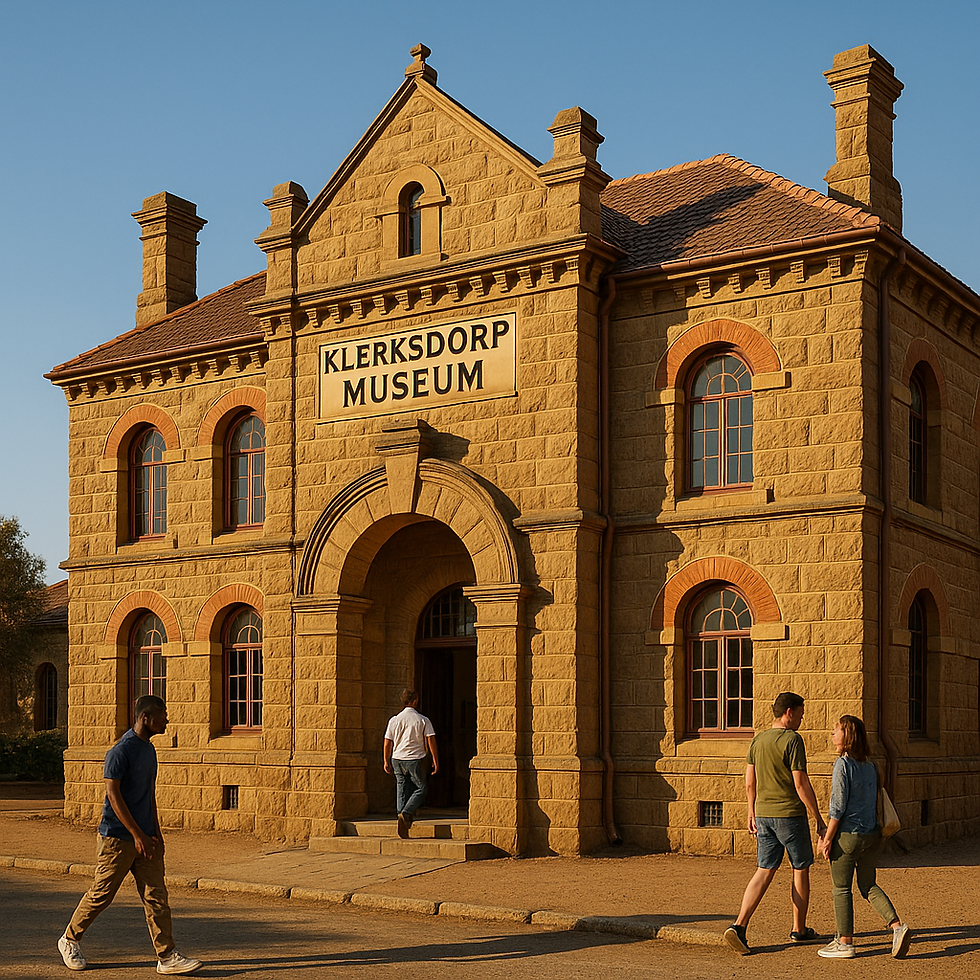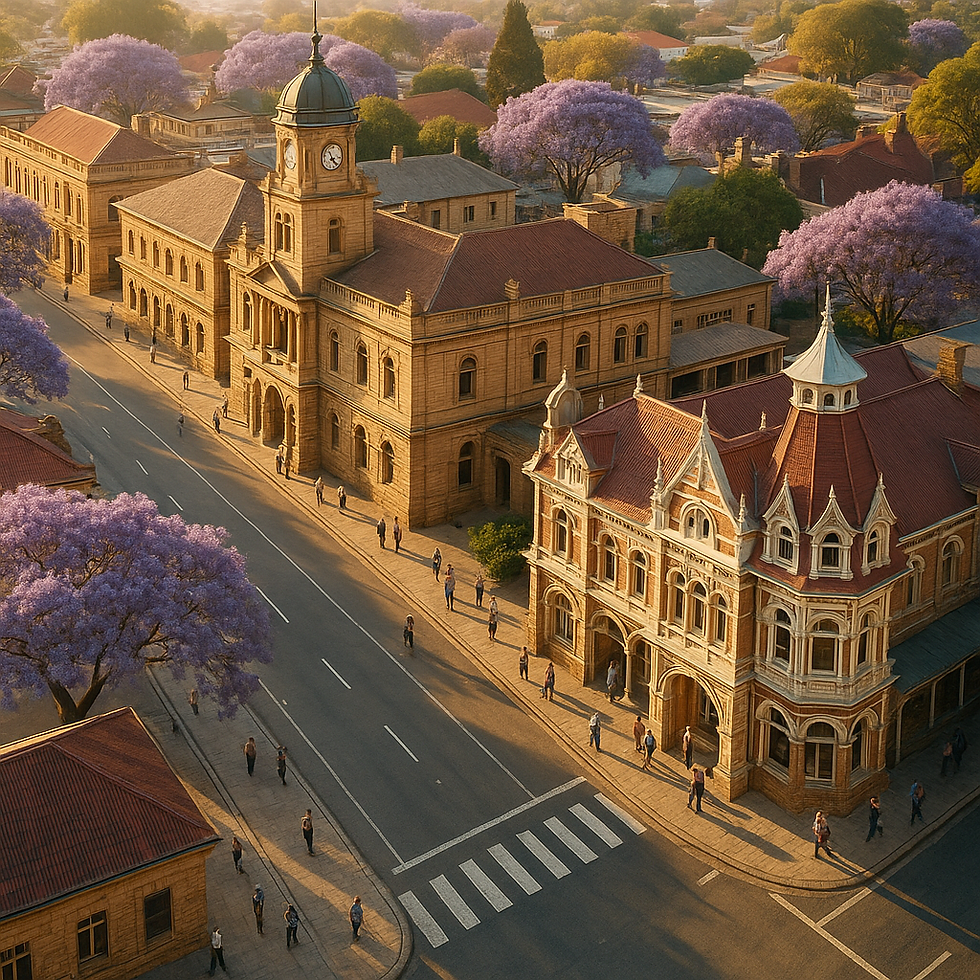Exploring Klerksdorp’s Timeless Treasures: A Local’s Historic Guide
- Charlene Bekker

- Aug 8
- 7 min read
Klerksdorp is a city that wears its history proudly on its sleeve. Founded in 1837 by Voortrekker settlers, it ranks among the oldest European settlements north of the Vaal River. Today, its streets are dotted with timeless treasures, historic buildings, museums, and heritage sites, each with a tale to tell.

An external observer can’t help but notice the blend of old and new: from beautifully preserved 19th-century architecture to vibrant modern life humming alongside.
Whether you’re a local resident who passes these landmarks every day or a traveler discovering Klerksdorp for the first time, you’ll find plenty of cultural and architectural history to explore. This guide shines a spotlight on several of Klerksdorp’s must-see historic gems, offering a lively journey through the city’s rich past (with no mining required!).
Klerksdorp Museum – A Time Capsule of History
One of the best places to begin a historic tour of Klerksdorp is the Klerksdorp Museum, the city’s own time capsule of local heritage. The museum is housed in a charming Victorian-era sandstone building completed in 1891, originally built as the town prison! Walking up to its sturdy walls and iron-barred windows, you can easily imagine the many roles this building has played.
It served as the local jail from the late 19th century all the way until 1973, before being transformed into a museum dedicated to preserving Klerksdorp’s story. Inside, the museum’s exhibits span archaeology, early settler life, and the diverse cultural history of the region. You’ll find everything from indigenous artifacts and pioneer farm implements to lovingly recreated period rooms that depict everyday town life in bygone eras.

The curators keep things dynamic with rotating temporary exhibitions and engaging displays, so there’s always something new to learn on each visit. For an even deeper dive, the museum offers guided tours by appointment, where knowledgeable guides share anecdotes that truly bring local history to life.
Standing in the former cell blocks turned exhibition halls, one can’t help but feel connected to the generations of Klerksdorpers who walked these halls before, making the museum a must-see for history enthusiasts and curious minds alike.
Old Town Architecture – Strolling Through History
To experience Klerksdorp’s past in its very fabric, take a leisurely stroll through the Old Town heritage quarter. The oldest parts of Klerksdorp (known as “Oudorp,” Afrikaans for old town) are a treasure trove of historic architecture, where century-old buildings still grace the streets.
In fact, Hendrik Potgieter Street and Convent Avenue form a recognized heritage cluster with one of the largest concentrations of 19th-century buildings in the city. Walking along these avenues feels like stepping back in time. You’ll see quaint cottages with wood-and-iron construction, humble yet charming houses that date back to the late 1800s.
Two such cottages at 13 and 15 Convent Avenue, with their tin roofs and simple facades, have even been declared Provincial Heritage Sites. These preserved homes offer a glimpse into the everyday life of Klerksdorp’s early residents, reminding passersby that even ordinary residences can be historical treasures.

Just a short distance away stands Fountain Villa on Hendrik Potgieter Street – a striking contrast to the simple cottages. This stately Victorian-era house, once a private residence, has been lovingly restored and now serves as a quaint guesthouse.
Recognized as a National Heritage property, Fountain Villa showcases the more elegant side of Klerksdorp’s architectural legacy. Its ornate gables, spacious verandas, and period details harken back to an era of gracious living. Many a traveler has been charmed by the blend of history and hospitality found within its walls.
As you wander the tree-lined streets of the old town, you’ll likely spot other historical gems as well - from old merchant buildings to vintage schools, each with unique architecture reflecting the styles of their time. Informational plaques on some structures provide background, so don’t hesitate to pause and read the stories of these buildings.
The entire area has an atmosphere of nostalgia, making it a delightful open-air museum of Klerksdorp’s journey through the decades. It’s easy to see why locals are proud of these heritage homes and why visitors find the Old Town walk so enchanting.
The Grand Railway Station – Echoes of a Bygone Era
No historic tour of Klerksdorp would be complete without a look at its grand old Railway Station. Situated on Delver Street, the Klerksdorp railway station is an architectural landmark that evokes the romance of the steam age.
The station was completed in 1897 by the NZASM (Netherlands South African Railway Company), and over a century later it remains one of only a few elegant 19th-century station buildings still standing in South Africa. Its design reflects the optimism and prosperity of the era when railroads first connected Klerksdorp to the wider world.
The building’s graceful proportions, decorative trim, and expansive platform arches speak to a time when even utilitarian structures were built with style. For about nine years after its completion, this station was the western terminus of the line; a bustling hub where farmers, traders, and travelers arrived in town, greeted by the station’s distinctive façade.

Today, the old station no longer sees the stream of steam locomotives it once did, but it has not lost its charm. The exterior has been maintained, and one can almost picture the scene a hundred years ago: the whistle of a train approaching, passengers in period dress on the platform, porters loading mailbags and trunks.
In recent times, there have been efforts to repurpose and preserve the station, given its historical importance (some parts have hosted a transport museum exhibit). Even if you just view it from the outside, the Klerksdorp Railway Station offers wonderful photo opportunities, especially in the golden afternoon light.
It stands as a proud testament to the city’s growth and connectivity in a bygone era, truly an echo of history nestled amid modern buildings. For lovers of architecture and vintage transport, stopping by this station is a highlight, allowing you to literally stand where countless journeys began and ended over the decades.
St. Mary’s and the Mother Church – Sacred Landmarks
Klerksdorp’s historic landscape is not only about homes and stations; it’s also graced by beautiful places of worship that have served the community for generations. The most iconic of these is the Nederduitse Gereformeerde Moederkerk, or Dutch Reformed “Mother Church,” which towers over the downtown area.
his impressive stone church dates back to the 1890s, its cornerstone was laid in March 1898 with great fanfare, even attended by General Piet Joubert, then deputy president of the Zuid-Afrikaansche Republiek. Over 120 years later, the Mother Church remains a centerpiece of Klerksdorp’s heritage. Its architecture is classic and grand: think lofty steeple, arched windows, and a serene Neo-Gothic interior that fills with colored light when the sun pours through the stained glass.
The church is officially recognized as a Provincial Heritage Site, and standing before it, you’ll understand why. Generations of townspeople have been baptized, married, and eulogized under its vaulted roof. Visitors are welcome to admire the exterior and, if timing allows, step inside to appreciate the tranquility and craftsmanship (do be respectful, as it’s still an active house of worship).

Another noteworthy church is St. Mary’s Anglican Church, a charming sandstone chapel that also dates to the turn of the 20th century. With its quaint bell tower and lancet windows, St. Mary’s reflects the modest beauty of Gothic Revival architecture often seen in small colonial towns. It has its own rich history of serving English-speaking congregants in Klerksdorp for well over a century.
These sacred landmarks not only offer spiritual sustenance but also anchor the city’s historical skyline. Even from an architectural perspective, they are marvels of design and construction for their time. As you explore Klerksdorp, take a moment in the quiet churchyards, you might hear the echoes of old hymns on the breeze or imagine the community gatherings that once filled these grounds on Sunday mornings. The enduring presence of these churches reminds us that Klerksdorp’s story is also one of faith, community, and continuity across the ages.
Embracing Klerksdorp’s Heritage
As our journey through Klerksdorp’s historic sites comes to a close, it’s clear that this city is much more than a dot on the map, it’s a living chronicle of South African history. From the museum’s curated collections to the weathered facades of old shops and homesteads, every corner of Klerksdorp has a story to share.
One of the best ways to soak it all in is to follow the Oudorp Heritage Trail, a roughly 12 km walking route that winds through the city’s oldest neighborhoods. Along this trail, informative signboards guide you through various points of interest, making it easy for both tourists and locals to appreciate the significance of each site.
You’ll traverse the same paths as early settlers, cross the tranquil Schoonspruit stream that drew farmers here in the 1830s, and end up with a panoramic understanding of how Klerksdorp grew from a rustic settlement to the bustling town we see today.

Exploring Klerksdorp’s timeless treasures is a vivid trip back in time. It’s walking under the shade of an old oak planted by someone long forgotten, hearing the distant whistle of a phantom train at the station, and picturing families in Victorian attire chatting on a veranda at sunset.
The city’s historic sites aren’t roped off or frozen in time; they are woven into everyday life, a schoolchild might eat lunch on the steps of a monument, or a couple might say “I do” in the very church their great-grandparents attended. This seamless blend of past and present gives Klerksdorp a unique charm.
Whether you are a history buff, an architecture enthusiast, or simply a curious explorer, Klerksdorp offers a welcoming journey through its heritage. Take your time as you wander these streets and buildings; imagine the events they have witnessed and the lives they have touched.
By the end of your tour, you’ll have not only collected beautiful photos and interesting facts, but also a deeper appreciation for how this community has evolved while keeping its heritage alive. Klerksdorp’s historic guide may have been written by time itself, but it’s up to each visitor to turn the pages and trust us, every page is worth reading in this fascinating town. Enjoy your exploration of Klerksdorp’s timeless treasures, and carry a piece of its history with you when you leave!









Comments